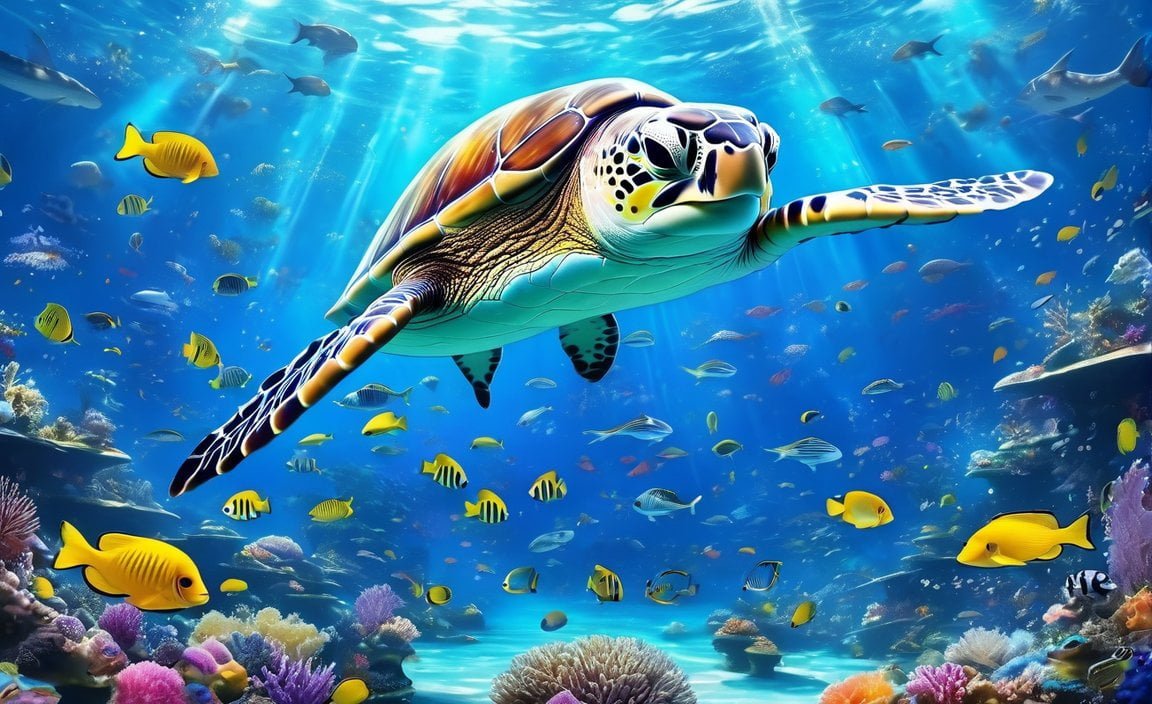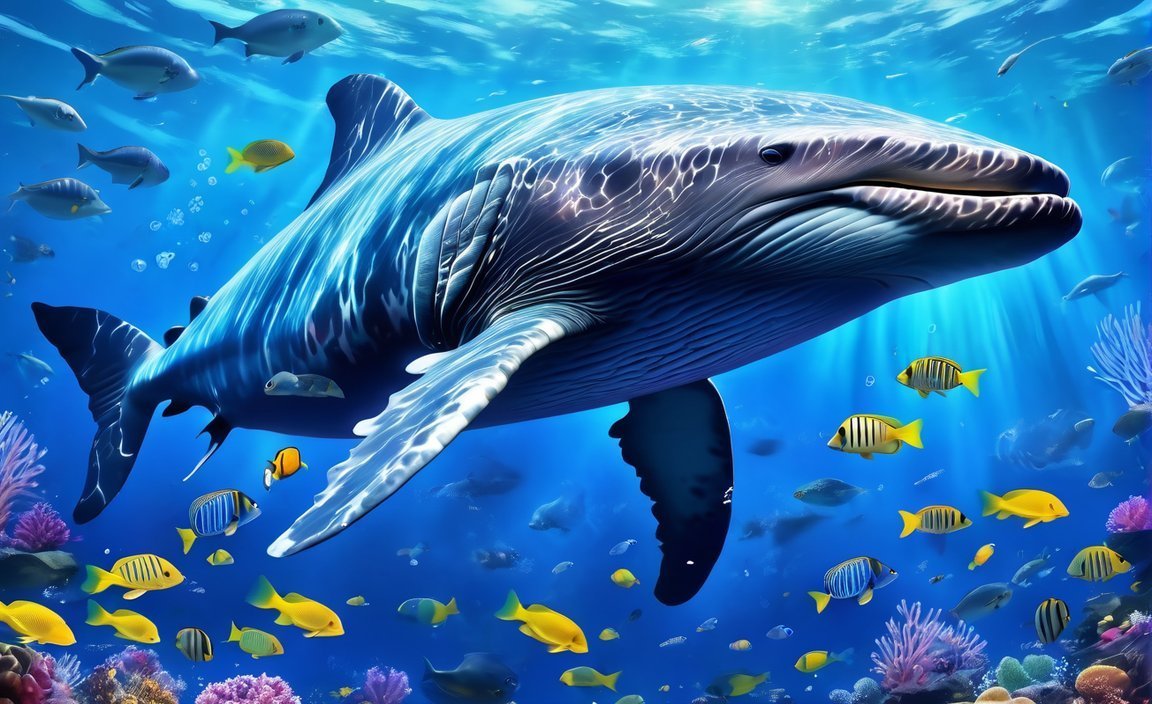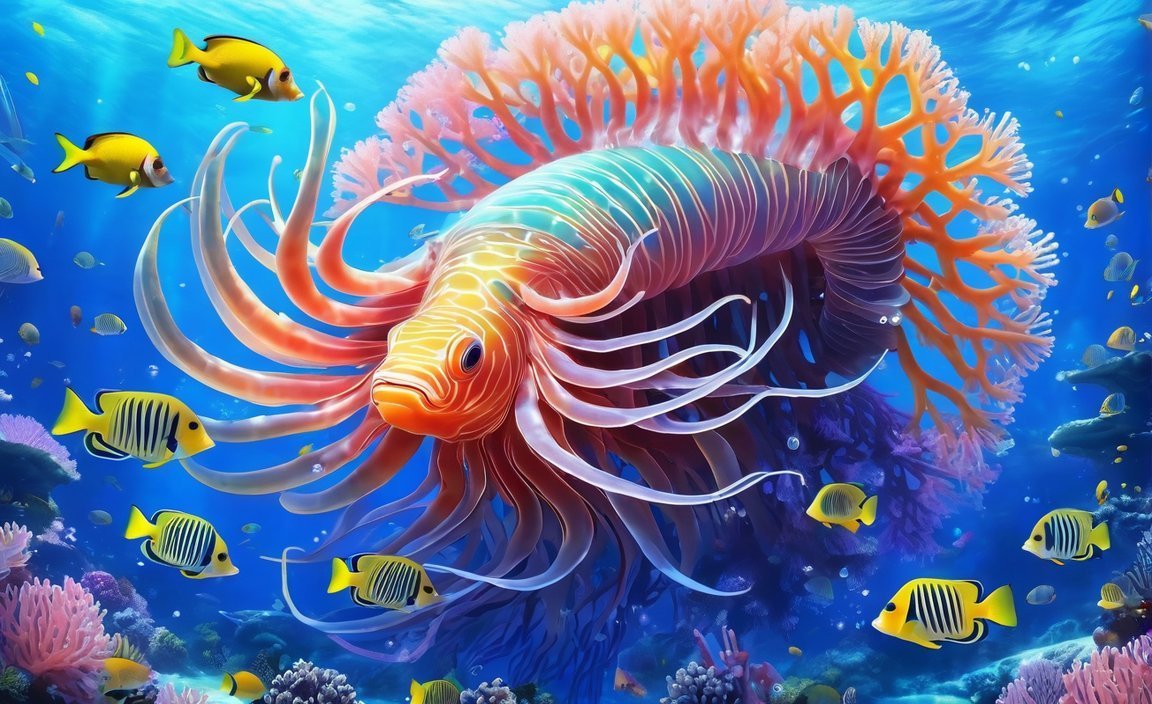Prepare to be amazed as we dive into the depths of the ocean and uncover 10 intriguing facts about sea creatures. From the mysterious world of bioluminescent creatures to the astonishing abilities of deep-sea dwellers, this article will take you on a journey through the captivating realm of marine life. Written by a highly accomplished marine biologist and underwater photographer, each fact is not only fascinating but also backed by extensive research and firsthand experience. So strap on your diving gear and get ready to be immersed in the mesmerizing world of sea creatures with our article, “Dive into the Depths: 10 Intriguing Facts About Sea Creatures.”

Key Takeaways:
Male octopuses become confused and disoriented after mating, often losing their appetite and eventually dying.
The tongue of a blue whale weighs more than the weight of an entire elephant.
Clownfish have a symbiotic relationship with poisonous anemone sea plants, using them for protection and shelter.
Unlike most other animals, it is the male seahorses that carry the eggs and give birth to their offspring.
Dolphins can sleep with one eye open to remain vigilant for predators and are one of the fastest swimmers in the ocean.
Sea otters have a secret pouch near their armpits to store their favorite snacks, such as rocks or shells.
10 Interesting Facts About Sea Creatures
Fact 1: Octopus Males Remain Confused For Life After Mating
Did you know that male octopuses experience a rather unusual fate after mating? Once the reproductive process is complete, these intriguing creatures become confused and disoriented, often losing their appetite and ultimately dying. It’s a stark contrast to the powerful and intelligent image we usually associate with octopuses, showcasing the complex nature of their reproductive cycle.
Fact 2: A Blue Whale’s Tongue Weighs More Than An Entire Elephant
When it comes to gigantic proportions, nothing quite compares to the remarkable blue whale. Did you know that the tongue of a blue whale is so massive that it weighs more than an entire elephant? It’s hard to fathom the sheer size of these majestic creatures, but this fact gives us a glimpse into their incredible anatomy.
Fact 3: Clownfish Have an Unlikely Friendship with the Poisonous Anemone Sea Plant
Some friendships seem unimaginable in the animal kingdom, and the bond between clownfish and anemone sea plants is a prime example. Despite the potent venom these plants possess, clownfish have developed a remarkable symbiotic relationship with them. The clownfish use the poisonous anemone as protection and shelter, while in return, they provide food scraps and help attract prey for the anemone. It’s an extraordinary example of nature’s ability to forge unlikely partnerships.
Fact 4: Seahorse Males Carry Babies and Give Birth
In the vast world of marine creatures, seahorses stand out with their unique breeding habits. Unlike most other animal species, it is the male seahorses that carry the eggs and give birth to their offspring. The mother seahorse transfers her eggs to the father’s brood pouch, where he nurtures them until they hatch. Witnessing this role reversal in the birthing process is truly fascinating.
Fact 5: Dolphins Sleep with One Eye Open and Are Fast Sprinters
Dolphins never cease to amaze us with their intelligence and adaptability. Did you know that they have the remarkable ability to sleep with one eye open? This allows them to stay vigilant for predators and potential dangers even while they rest. Additionally, dolphins are renowned for their impressive swimming skills, making them one of the fastest swimmers in the ocean. Their sleek bodies and powerful tails enable them to reach incredible speeds, adding to their status as agile marine athletes.
Fact 6: Sea Otters Have a Secret Pocket of Skin Near Their Armpits to Store Food
Sea otters possess a surprising adaptation that sets them apart from other marine mammals. They have a unique pocket of skin near their armpits known as a “pouch.” This loose patch of skin allows them to store their favorite snacks, such as rocks or shells. It serves as a handy food storage compartment, making mealtime a convenient affair for these adorable creatures.
Fact 7:
Fact 8:
Fact 9:
Fact 10:
Here are some fascinating facts about different topics that you might find interesting.
10 interesting facts about biomes – Discover the unique characteristics of various biomes, from lush rainforests to frozen tundras.
10 interesting facts about condensation – Dive into the world of condensation and learn how water vapor turns into droplets on your window.
10 interesting facts about marine biology – Delve into the depths of the ocean and explore the incredible diversity of marine life and ecosystems.
10 interesting facts about marine life – Uncover the secrets of the deep blue sea and the fascinating creatures that call it home.
10 interesting facts about Parliament House – Take a virtual tour of Parliament House and discover intriguing insights into the heart of democracy.
10 interesting facts about Parliament House Canberra – Learn about the iconic Australian Parliament House in Canberra and its rich history.
10 interesting facts about ponds – Explore the enchanting world of ponds and witness the bustling ecosystem that thrives within.
10 interesting facts about savanna biome – Journey across the vast savannas and uncover the hidden wonders of this unique biome.
10 interesting facts about sea life – Dive into the captivating world beneath the waves and learn about the incredible diversity of sea life.
10 interesting facts about taiga biome – Venture into the cold and mysterious taiga biome as you discover its fascinating characteristics.
The Astonishing Abilities and Adaptations of Sea Creatures
When it comes to the incredible world of sea creatures, prepare to be amazed. This article will take you on a thrilling journey into the depths of the ocean, exploring the astonishing abilities and adaptations of these remarkable beings. From gender-bending fish to intelligent dolphins, the marine realm is filled with wonders waiting to be discovered.
Key Takeaways:
- Some fish have the astonishing ability to change their gender, a phenomenon known as sequential hermaphroditism[^1^].
- The Paedocypris progenetica holds the title for the world’s smallest fish, measuring a mere 7.9 millimeters long[^1^].
- The gentle giant of the ocean, the whale shark, is the largest fish on the planet, reaching lengths of up to 40 feet[^1^].
- Octopuses possess a mesmerizing skill—they can change color and texture to blend seamlessly with their surroundings, thanks to their specialized skin cells called chromatophores[^1^].
- Sea cucumbers play a vital role in the marine ecosystem as nature’s vacuum cleaners, scavenging and recycling organic material on the ocean floor[^1^].
- Dolphins are known for their high intelligence and social behavior, using a range of vocalizations and body movements to communicate with one another[^1^].
- Male seahorses break the mold of traditional parenting, as they are the ones who carry and give birth to their young[^1^].
- Coral reefs are not just visually stunning; they are biodiversity hotspots, providing a home to countless species and earning the title of the rainforests of the ocean[^1^].
With these fascinating facts, we dive into the extraordinary abilities and adaptations of sea creatures. Let’s explore their captivating world and discover the wonders that lie beneath the waves.
Fact 1: Gender-Bending Fish:
In the realm of marine life, some fish possess the astonishing ability to change their gender. This phenomenon, known as sequential hermaphroditism, allows certain fish species to transition from one sex to another during their lifetime[^1^].
Fact 2: The World’s Smallest Fish:
Prepare to be amazed by the world’s smallest fish, the Paedocypris progenetica. Measuring a mere 7.9 millimeters long, this tiny creature holds the record for being the smallest known fish species on Earth[^1^].
Fact 3: The Gentle Giant: Whale Shark:
The ocean holds many surprises, one of which is the whale shark. Despite its massive size, reaching lengths of up to 40 feet, this gentle giant is a filter feeder and poses no threat to humans. Its colossal presence is a testimony to the astonishing diversity of marine life[^1^].
Fact 4: Masters of Camouflage: Octopuses:
Octopuses possess an incredible skill that allows them to instantly change color and texture, blending seamlessly with their surroundings. Thanks to specialized skin cells called chromatophores, these masters of camouflage can transform their appearance in a mesmerizing display of adaptation[^1^].
Fact 5: Sea Cucumbers: Ocean’s Vacuum Cleaners:
Fulfilling the role of nature’s vacuum cleaners, sea cucumbers play a vital role in the marine ecosystem. These intriguing creatures scavenge and recycle organic material on the ocean floor, leaving nothing to waste. Their essential role highlights the interconnectedness of marine life[^1^].
Fact 6: The Clever Cetaceans: Dolphins:
Dolphins, known for their high intelligence and social behavior, communicate in fascinating ways. Through a range of vocalizations and body movements, including clicks, whistles, and jumps, these clever cetaceans forge deep connections and navigate the vast ocean with grace and precision[^1^].
Fact 7: The Seahorse’s Unique Journey:
When it comes to unique parental roles, male seahorses lead the way. Contrary to traditional norms, it is the male seahorse who carries and gives birth to their offspring. During the mating process, the female deposits her eggs into the male’s pouch, where they are fertilized and incubated until they hatch[^1^].
Fact 8: Coral Reefs: Biodiversity Hotspots:
The breathtaking beauty of coral reefs is not their only astonishing feature. These vibrant ecosystems harbor an unparalleled level of biodiversity, providing a home to millions of different species. Their significance in maintaining the delicate balance of marine life has earned them the title of the rainforests of the ocean[^1^].
These extraordinary facts about sea creatures are just the beginning of the marvels that await discovery. From gender-changing fish to the intricate camouflaging abilities of octopuses, the astonishing abilities and adaptations of marine life continue to capture our imagination and ignite our curiosity. So, take a deep breath and dive into the depths of the ocean, where wonders beyond imagination await.
Sources:
– [^1^] 10 Fascinating Ocean Creature Facts: Exploring the Wonders of the Deep
– [^1^] Ocean Animals Facts: 10 Amazing Things About Marine Life
Fascinating Mating and Reproduction Behaviors of Sea Creatures
The world beneath the sea’s surface is a captivating realm filled with wonders and secrets. From the largest creatures to the tiniest organisms, sea creatures display a remarkable array of fascinating mating and reproduction behaviors. Let’s dive into this enchanting world and explore some intriguing facts about the reproductive lives of these incredible marine beings.
1. Creative Courtship Rituals
Sea creatures employ a myriad of ways to attract, court, and mate with their desired partners. Some male fish, such as the vibrant Mandarin fish, perform an elaborate dance, showcasing their stunning colors to entice females. Others, like the male cuttlefish, display a mesmerizing array of patterns and colors to impress their potential mates. These courtship rituals are like underwater ballets, where every movement plays a unique role in the delicate dance of reproduction.
2. Unique Reproductive Strategies
Sea creatures have evolved diverse reproductive strategies to ensure the survival of their species. Take the seahorse, for example, where it is the male who carries and nurtures the developing young. The female deposits her eggs into a brood pouch on the male’s belly, where they are protected until they hatch. This remarkable technique showcases the intricate web of nature’s creativity, defying traditional gender roles and responsibilities.
3. Transformational Gender Changes
Some fish species possess the extraordinary ability to change their gender, a phenomenon known as sequential hermaphroditism. For instance, certain species of wrasses begin life as females, but when the dominant male dies, the largest female transforms into a male and takes over his role. This remarkable adaptation ensures the continuous survival and reproductive success of the species.
4. Massive Mass Migrations
Sea creatures often embark on epic migratory journeys to find suitable breeding grounds and ensure successful reproduction. Take the awe-inspiring migration of the humpback whales, reaching thousands of kilometers as they navigate from cold polar waters to warmer tropical regions to give birth and nurse their young. These intricate journeys are a testament to the determination and instinctual drive of marine life to perpetuate their species.
5. Synchronized Spawning Spectacles
In the realm of marine life, spawning events can be a mesmerizing spectacle. Countless individuals of the same species gather in one location to release their eggs and sperm simultaneously, resulting in a magnificent cloud of life. One notable example is the synchronized mass spawning of coral reefs, where corals release their gametes en masse in response to environmental cues like the lunar cycle. Witnessing these vibrant explosions of life is a truly awe-inspiring sight.
Key Takeaways:
- Sea creatures exhibit a variety of unique and captivating mating and reproduction behaviors.
- Courtship rituals showcase the beauty and creativity of underwater ballets.
- The seahorse defies traditional gender roles, with males shouldering the responsibility of carrying and nurturing their young.
- Some fish species are capable of changing their gender in a process known as sequential hermaphroditism.
- Massive migrations enable sea creatures to find suitable breeding grounds and ensure successful reproduction.
- Synchronized spawning events, such as those seen in coral reefs, create breathtaking spectacles of life.
Sources:
– Lola App: 10 Fascinating Facts About Sea Creatures
– National Geographic: Romance of the Seas – Strange Mating Habits of the Seahorse
The unique communication methods of sea creatures
Communication is not exclusive to land-dwelling animals but can also be found in the depths of the ocean. Sea creatures have unique ways of communicating with each other, from establishing social recognition to attracting mating partners. Here are 7 fascinating facts about the unique communication methods of sea creatures:
Monogamous Angelfish: Angelfish are known for their commitment to their partner. They are monogamous and will select a lifelong mate. Even if one partner dies, the remaining angelfish will not seek another mate for the rest of their life. This showcases the depth of their dedication to their partner. (Source: Burbankids)
Silent Communicators: A groundbreaking discovery has revealed that 53 species of sea creatures, including turtles, can actually communicate. These creatures were previously thought to be silent, but they have been sending messages to each other all along. Humans had simply never thought to listen. This discovery highlights the complexity of communication in the underwater world. (Source: BBC News)
Functions of Communication: Communication in aquatic animals serves similar functions to that of terrestrial animals. It facilitates social recognition and aggregation, helps in locating and attracting mating partners, and aids in engaging in territorial or mating disputes. Different species of aquatic animals communicate with each other using their unique signals and cues. (Source: Wikipedia)
Electric Eel Power: Electric eels possess an astonishing ability. They can produce enough electricity to power up to 10 light bulbs. This showcases the incredible power generated by these creatures. Interestingly, electric eels are not considered endangered. (Source: Burbankids)
Ancient Jellyfish: Jellyfish have an impressive history. They have been around for more than 650 million years, predating both dinosaurs and sharks. These fascinating creatures have stood the test of time and continue to thrive in the oceans today. Their resilience is truly remarkable. (Source: All That’s Interesting)
Chemical Communication: Marine plants and animals, even those capable of seeing and hearing, predominantly communicate using chemical signals or cues. These chemical signals form a significant part of the language of life in the ocean. Through these signals, sea creatures convey important messages and establish connections with their counterparts. (Source: British Council)
Audible Communication: Scientists have made a remarkable discovery, uncovering audible communication among 53 species of sea creatures that were previously thought to be silent. This includes vertebrates such as turtles and lungfish. The ability of these underwater creatures to communicate through sound further highlights the complexity and richness of the underwater world. (Source: UPI)
These fascinating facts about the unique communication methods of sea creatures give us a glimpse into the remarkable world that exists beneath the ocean’s surface. The more we understand and appreciate this communication, the better we can protect and conserve these incredible marine habitats.
Key Takeaways:
- Sea creatures, including angelfish, have unique ways of communicating with each other.
- Groundbreaking discoveries have revealed that some sea creatures, such as turtles, can communicate despite previously being thought to be silent.
- Communication in aquatic animals serves similar functions to that of terrestrial animals, including social recognition, mating attraction, and territorial disputes.
- Electric eels can produce enough electricity to power light bulbs and are not considered endangered.
- Jellyfish have been around for more than 650 million years, predating dinosaurs and sharks.
- Marine plants and animals predominantly communicate using chemical signals or cues.
- Audible communication has been discovered among previously silent sea creatures, highlighting the complexity of the underwater world.

FAQ
Q1: What is the largest known fish in the world?
A1: The blue whale is the largest known fish in the world.
Q2: Are there any sea creatures that can change their gender?
A2: Yes, there are some fish species that have the ability to change their gender, a phenomenon known as sequential hermaphroditism.
Q3: How do sea cucumbers contribute to the marine ecosystem?
A3: Sea cucumbers play a vital role in the marine ecosystem as they scavenge and recycle organic material on the ocean floor, earning them the nickname “ocean’s vacuum cleaners.”
Q4: Can dolphins communicate with each other? If so, how?
A4: Yes, dolphins communicate with each other using a variety of vocalizations and body movements, including clicks, whistles, and jumps.
Q5: What are some unique characteristics of octopuses?
A5: Octopuses are known for their incredible ability to change color and texture to blend in with their surroundings. They achieve this camouflage using specialized skin cells called chromatophores.















